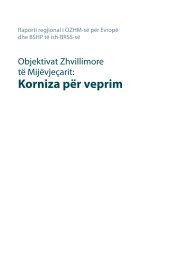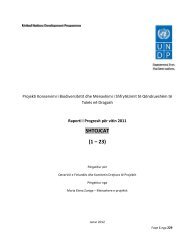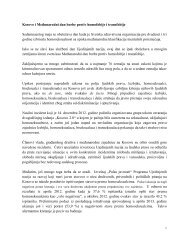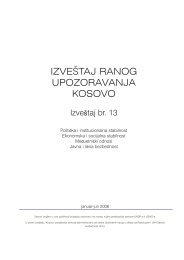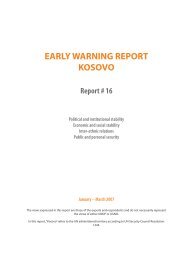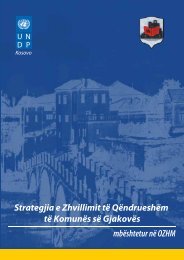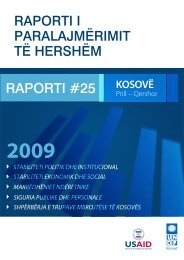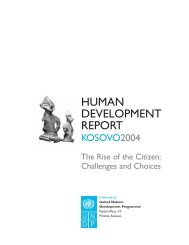Kosovo Human Development Report 2010 - UNDP Kosovo - United ...
Kosovo Human Development Report 2010 - UNDP Kosovo - United ...
Kosovo Human Development Report 2010 - UNDP Kosovo - United ...
Create successful ePaper yourself
Turn your PDF publications into a flip-book with our unique Google optimized e-Paper software.
FIGURe<br />
75 percent of male youth aged 15-24<br />
unemployed. Only 8 percent of working<br />
Roma hold managerial positions<br />
in comparison to 13.9 percent of ethnic<br />
<strong>Kosovo</strong>-Serbs and 15.8 percent of<br />
other minority groups.<br />
FIGURe<br />
2.5<br />
0%<br />
2%<br />
4%<br />
Prishtinë/Priština<br />
2.6<br />
Percentage of households exluded from all factor markets across regions<br />
Source: Calculated from <strong>Kosovo</strong> Mosaic Survey, <strong>UNDP</strong> 2009<br />
10%<br />
9%<br />
8%<br />
7%<br />
6%<br />
7%<br />
4%<br />
3%<br />
2%<br />
1%<br />
0%<br />
1-9<br />
6%<br />
8%<br />
10%<br />
12%<br />
Mitrovicë/Mitrovica<br />
10-12<br />
Years of schooling and exclusion<br />
from all factor markets<br />
9.2%<br />
13-16<br />
9.1%<br />
9.0%<br />
Prizren<br />
17-23<br />
Source: Calculated from <strong>UNDP</strong>s Mosaic Survey<br />
5.0%<br />
Gjakovë/Đjakovica<br />
2.8%<br />
1.7%<br />
Gender: women in <strong>Kosovo</strong> face<br />
much lower access to factor markets<br />
than men (see Table 2.7). 55 According<br />
to the latest Labour Force Survey,<br />
labour force participation rates are<br />
distinctively lower for women: 26.1<br />
percent compared to 65.8 percent for<br />
men. This means that out of 10 women<br />
that are of working age, 7.4 do not participate<br />
in the labour market. By comparison,<br />
the EU average female labour<br />
force participation rate in 2007 was 64<br />
percent. Despite relatively low partici-<br />
pation rates among women, in 2008<br />
the female unemployment rate was<br />
about 17 percentage points higher<br />
than the one for the males.<br />
Employment is only one facet of<br />
women’s exclusion from factor markets.<br />
Their participation as owners of<br />
land or business is even lower. SHE-<br />
ERA, a women’s business association in<br />
<strong>Kosovo</strong>, reported that only 6 percent of<br />
all registered businesses were owned<br />
by women in 2006. 56 The ‘Women<br />
FIGURe<br />
9.9%<br />
Gjilan/Gnjilane<br />
0%<br />
5%<br />
2.7<br />
10%<br />
15%<br />
20%<br />
25%<br />
30%<br />
4.2%<br />
Pejë/Peč<br />
9.2%<br />
Ferizaj/Uroševac<br />
7.0%<br />
Percentage of households excluded from all factor<br />
markets broken down by ethnicity<br />
35%<br />
40%<br />
45%<br />
50%<br />
8.1%<br />
Source: Calculated from <strong>UNDP</strong>s Mosaic Survey<br />
<strong>Kosovo</strong><br />
3.0%<br />
K-albanian K-Serb K-Rae other<br />
6.9%<br />
40.6%<br />
7.6%<br />
ECONOMIC AND LABOUR MARKET EXCLUSION | 43<br />
5.4%



